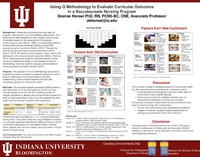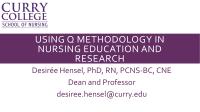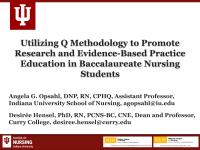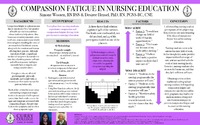| dc.contributor.author | Hensel, Desiree | en |
| dc.date.accessioned | 2016-07-13T11:10:13Z | |
| dc.date.available | 2016-07-13T11:10:13Z | |
| dc.date.issued | 2016-07-13 | |
| dc.identifier | INRC16PST43 | |
| dc.identifier.uri | http://hdl.handle.net/10755/616336 | |
| dc.description | <p>Theme: Leading Global Research: Advancing Practice, Advocacy, and Policy</p> | en |
| dc.description.abstract | <p>Session presented on Thursday, July 21, 2016 and Friday, July 22, 2016:</p>
<p><strong>Purpose: </strong>Attainment of learning outcomes in our program, like many programs, has been measured on Likert-scales as self-perception and preceptors' ratings. This information often lacks the depth to be used in meaningful ways for program improvement. The National League for Nursing has made examination of innovative program evaluation models a research priority. Accordingly, we trialed using Q methodology as part of our evaluation process. Q methodology is a research method that correlates participant profiles to each other to find groups with shared viewpoints and has the potential to offer a richer understanding of perceptions. The purpose of this project was to evaluate how students attained the program outcome of being prepared to practice in diverse environments by exploring the types of patients students felt that they would most likely care for after graduation.</p>
<p><strong>Methods:</strong> Institutional review board approval was obtained to conduct this study at our large public university in the Midwestern United States. We used Q methodology to discover groups of students with shared viewpoints on who would be their future patients. The recruited sample consisted of baccalaureate students near graduation from a traditional program. Students sorted 45 images of diverse patients printed on a deck of cards into three piles according to whether they agreed, disagreed, or felt unsure about whether they might care for that type of patient early in their nursing career. Twenty-two images reflected acute care settings and 23 cards showed patients in community-based or extended care settings. Participants then rank-ordered their selections and recorded their preferences on a -5 to +5 sorting sheet. Analysis was done through a standard 3-step process using PQMethod 2.35 software. Participant profiles were correlated to each other, centroid factor analysis with varimax rotation was completed to find groups with shared viewpoints, and factor scores were calculated for each statement. A factor array and narrative were created to describe each factor.</p>
<p><strong>Results:</strong> One unipolar and two bipolar factors explained 58% of the variance with participants tending to see themselves caring for a narrow range of types patients. Students averaged disagreeing that they would care for patients portrayed in the images (M=20.8) more than they agreed they might care for that type of patient (M= 12.5). Participants loading Factor 1 mostly saw themselves caring for adults in acute care settings. Positive loads on Factor 2 were characterized by wanting to care for pediatric patients but not older adults. Negative Factor 2 loads showed the reverse preference. Those loading positively on Factor 3 showed the preference of caring for Maternal-newborn patients but not critical care patients. Negative Factor 3 loads preferred critical care and did not see themselves caring for perinatal patients.</p>
<p><strong>Conclusion:</strong> As the majority of healthcare shifts away from acute care settings, nursing curricula must evolve. The purpose of undergraduate education is to prepare a generalist, but our students showed preferences for specialized practice environments. A preference for providing care in non-acute care setting did not emerge. Students in this study took a dedicated developing family course and did not take community nursing until their senior year. More research is need to understand what role course design and sequencing plays in creating polarization of practice preferences or the primary desire to practice in exclusively in acute care settings.</p> | en |
| dc.format | Text-based Document | en |
| dc.language.iso | en | en |
| dc.subject | Nursing Education | en |
| dc.subject | Curriculum Evaluation | en |
| dc.subject | Q Methodology | en |
| dc.title | Using Q methodology to evaluate curricular outcomes in a baccalaureate nursing program | en |
| dc.type | Poster | en |
| dc.rights.holder | <p>
All rights reserved by the author(s) and/or publisher(s) listed in this item record unless relinquished in whole or part by a rights notation or a Creative Commons License present in this item record.
</p><p>
All permission requests should be directed accordingly and not to the Sigma Repository.
</p><p>
All submitting authors or publishers have affirmed that when using material in their work where they do not own copyright, they have obtained permission of the copyright holder prior to submission and the rights holder has been acknowledged as necessary.
</p> | |
| dc.description.note | <p>Items submitted to a conference/event were evaluated/peer-reviewed at the time of abstract submission to the event. No other peer-review was provided prior to submission to the Henderson Repository.</p> | |
| dc.type.category | Full-text | en |
| dc.evidence.level | N/A | en |
| dc.research.approach | N/A | en |
| dc.contributor.department | Alpha | en |
| dc.author.details | Desiree Hensel, RN, PCNS-BC, CNE | en |
| dc.conference.name | 27th international Nursing Research Congress | en |
| dc.conference.host | Sigma Theta Tau International | en |
| dc.conference.location | Cape Town, South Africa | en |
| dc.date.conferenceyear | 2016 | |
| dc.contributor.affiliation | Indiana University, Bloomington, Indiana, USA | en |
| dc.description.reviewtype | Abstract Review Only: Reviewed by Event Host | en |
| dc.description.acquisition | Proxy-submission | en |





